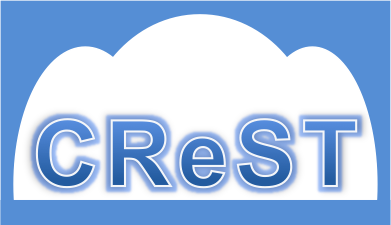| |
Download latest version of CReST
from the CReST project page hosted on SourceForge.
The Cloud Research Simulation Toolkit (CReST) is a discrete-event
cloud computing simulation platform written in Java. CReST was developed
to address the need for a robust simulation
modelling tool for research and teaching of data centre management and
cloud provision. CReST is a stand-alone application, written in Java,
and is freely available open source (GNU GPLv3). CReST has a unique
feature set that enables simulation at multiple abstraction levels:
from physical hardware, energy usage and thermal flows within a DC, to
networked infrastructure and the virtualisation layer of application
services supporting dynamic user demand.
Design:
CReST is designed as a set of coupled modules that can be
independently switched on or off depending on the level of
abstraction required. Modules include:
- Thermal: Heat generation, propagation and
extraction within the DC.
- Energy: Energy used by DC hardware.
- Failures: Permanent & temporary hardware failures.
- Replacements: New hardware specifications.
- Subscriptions: Middleware subscription network.
- Services: Scheduling and allocation of VMs.
- Pricing: Operational costs and pricing of services.
- Demand: User demand and cloud brokerage.
- UserEvents: User-defined events input via a text file.
- GUI: Real-time display.
The flexible and extensible architecture of CReST enables new modules
to be added, and current modules to be extended, as necessary.
Publications:
CReST has been used for research in the following publications:
-
J. Cartlidge & P. Clamp, (2014),
“Correcting a financial brokerage model for cloud
computing: closing the window of opportunity for commercialisation,”
Journal of Cloud Computing: Advances, Systems and Applications, vol. 3, no. 2, Apr 2014.
[Abstract]
[Open Access]
-
J. Cartlidge, (2014),
“Trading experiments
using financial agents in a simulated cloud computing commodity
market,” in Proc. 6th Int. Conf. Agents and
Artif. Intelligence, Vol. 2 - Agents (ICAART-2014).
B. Duval, J. van den Herik, S. Loiseau & J. Filipe, Eds.
Angers, France: SciTePress, Mar. 2014, pp. 311-317.
[Abstract]
[Camera-Ready Copy Available Online]
-
P. Clamp & J. Cartlidge, (2013),
“Pricing the cloud: An adaptive brokerage for cloud computing,”
in Proc. 5th Int. Conf. Advances in System Simulation (SIMUL-2013).
M. Bauer & P. Lorenz, Eds.
Venice, Italy: IARIA XPS Press, Oct 2013, pp. 113-121.
[Abstract]
[Open Access]
-
J. Cartlidge & D. Cliff, (2013),
“Comparison of Cloud Middleware Protocols and Subscription Network
Topologies using CReST, the Cloud Research Simulation Toolkit,”
in Proc. 3rd Int. Conf. Cloud Computing and Services Science (CLOSER-2013).
F. Desprez, D. Ferguson, E. Hadar, F. Leymann, M. Jarke & M. Helfert,
Eds. Aachen, Germany: SciTePress, May 2013, pp. 58-68.
[Abstract]
[Available Online]
-
P. J. Clamp, (2013), “Pricing The Cloud: An Investigation into
Financial Brokerage for Cloud Computing,”
Masters dissertation, Department of Computer Science,
University of Bristol, UK.
[Available Online]
For a detailed description of CReST, refer to Cartlidge & Cliff (2013).
Documentation:
The following documents are designed to help users and developers quickly
get started using and developing with CReST:
Download and Subversion Repository:
CReST is hosted on SourceForge. For all downloads, follow the link to the
CReST project webpage.
CReST is an open-source collaborative project and many developers have
contributed, including:
Philip Clamp, Dave Cliff, Luke Drury, Tomas Grazys, Sarah Haswell,
James Laverack, Callum Muir, Owen Rogers, Alex Sheppard and Ilango Sriram.
If you would like to get involved and add your name to the list above,
please contact John Cartlidge at the University of Bristol.
CReST: The Cloud Research Simulation Toolkit Copyright
© 2011, 2012, 2013 John Cartlidge
©John Cartlidge. Page last modified on:
|

